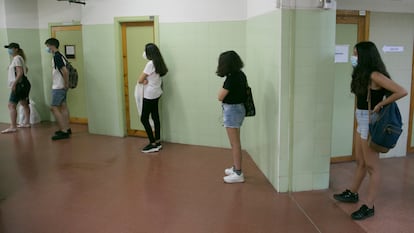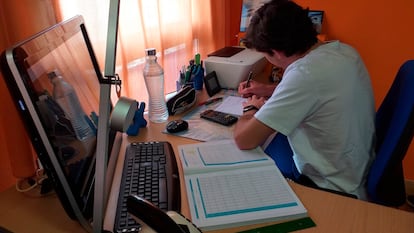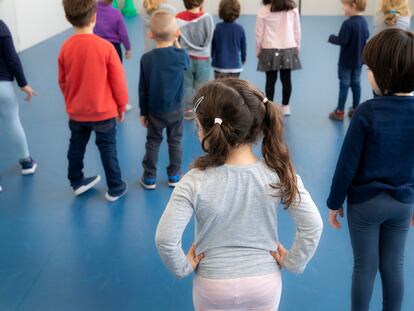Face masks and class ‘bubbles’: Spain prepares plans for a safe return to school
But regional officials say the central government's coronavirus guidelines for social distancing are impossible to observe due to space shortages

Spanish education officials have for weeks been debating how to get non-university students safely back to school in the fall for in-person classes.
Schools shut down across Spain in March due to the coronavirus pandemic and classes were moved online, but educators have been warning about the gaps in access to technology and the risk that some students could be left behind.
Central and regional officials are now working toward the goal of getting all children in pre-university studies back to school despite the logistical problems involved. One of the main issues is how to maintain a safe physical distance between students in facilities with large class sizes and reduced space.
The problem is that when the bubble gets very big, the risk of transmission is greater and controlling its components also gets more difficultQuique Bassat, pediatrician and epidemiologist
While the central government has issued a series of guidelines over the last few weeks, powers over education and healthcare are devolved to the regions. During the three-month state of alarm, health policy was partly recentralized as part of the government’s effort to contain the spread of the coronavirus.
But the emergency measures were lifted on Sunday, and healthcare reverted to the regions with the exception of what is stipulated in a government decree regulating Spain’s “new normality” following the lockdown. This decree will be subject to a congressional vote on Thursday.
This decree states that schools must take measures to avoid large groups and to guarantee a safe distance of at least 1.5 meters between children. But the text adds that when this distance is not possible, “the proper hygiene measures must be adopted to prevent the risk of contagion.”
Regional governments have taken this to mean that children may sit closer to each other, as long as they adopt alternative safety measures such as wearing a face mask at all times.
Class ‘bubbles’
Meanwhile, the central government has also accepted the creation of so-called class “bubbles” or groups of students who stay together and do not interact with other people at school. These groups will be allowed in early education and primary school, and may contain as many as 25 students who will not have to observe social distancing or wear face masks.
The government had originally talked about a safe distance of two meters and class sizes of no more than 15 children. But the issue of space, especially in high schools, has led authorities to gradually change these numbers in order to adapt to the reality on the ground.
Expert report
In May, the Spanish Pediatrics Association (AEP) drew up a report with recommendations for a safe return to school, including setting a two-meter distance between students, although the authors said that 1.5 meters could be acceptable as well.
These experts also defended the bubble formula for the youngest children, for whom social distancing is more difficult. This option also makes it easier to isolate a group in the event of an outbreak without the need to close down the entire school.
There is a division of opinion among experts whether these bubbles should have around 10 students, or whether they would still work with class sizes of up to 25. “The problem is that when the bubble gets very big, the risk of transmission is greater and controlling its components also gets more difficult,” notes Quique Bassat, a pediatrician and epidemiologist.
No space
Most regional governments, regardless of the political party in power, believe that it is impossible to create groups of 10 students and maintain the 1.5-meter distance, and still have enough space to bring all students back to school in the fall.
In the region of Castilla-La Mancha, for instance, some high schools have classes of up to 40 students (in early and primary school, the maximum allowed class size is 25). Observing the 1.5-meter distance would mean dividing such a class into three groups.

The labor union CC OO has calculated that breaking up these larger classes would require hiring 165,000 additional teachers at an annual cost of €5.15 million in the public education system alone. And this would not solve the problem of insufficient space for the extra groups.
For now, the central government has allocated an additional €2 billion for regional education spending, and a further €260 million to distribute 500,000 computers and tablets at schools.
Regional education officials are also questioning the theory behind the guidelines, noting that schools are being asked to adopt exceptional measures while other public venues such as libraries, museums, restaurants and stores are now allowed to operate at increased capacity, as long as people use face masks when social distancing is not possible.
Instead, regional governments support designing a gradual protocol that would increase restrictions where required, and which would lead to a complete school closure in a worst-case scenario of widespread transmission.
English version by Susana Urra.
Tu suscripción se está usando en otro dispositivo
¿Quieres añadir otro usuario a tu suscripción?
Si continúas leyendo en este dispositivo, no se podrá leer en el otro.
FlechaTu suscripción se está usando en otro dispositivo y solo puedes acceder a EL PAÍS desde un dispositivo a la vez.
Si quieres compartir tu cuenta, cambia tu suscripción a la modalidad Premium, así podrás añadir otro usuario. Cada uno accederá con su propia cuenta de email, lo que os permitirá personalizar vuestra experiencia en EL PAÍS.
¿Tienes una suscripción de empresa? Accede aquí para contratar más cuentas.
En el caso de no saber quién está usando tu cuenta, te recomendamos cambiar tu contraseña aquí.
Si decides continuar compartiendo tu cuenta, este mensaje se mostrará en tu dispositivo y en el de la otra persona que está usando tu cuenta de forma indefinida, afectando a tu experiencia de lectura. Puedes consultar aquí los términos y condiciones de la suscripción digital.
More information
Últimas noticias
Most viewed
- Reinhard Genzel, Nobel laureate in physics: ‘One-minute videos will never give you the truth’
- Oona Chaplin: ‘I told James Cameron that I was living in a treehouse and starting a permaculture project with a friend’
- Pablo Escobar’s hippos: A serious environmental problem, 40 years on
- Why we lost the habit of sleeping in two segments and how that changed our sense of time
- Chevy Chase, the beloved comedian who was a monster off camera: ‘Not everyone hated him, just the people who’ve worked with him’










































